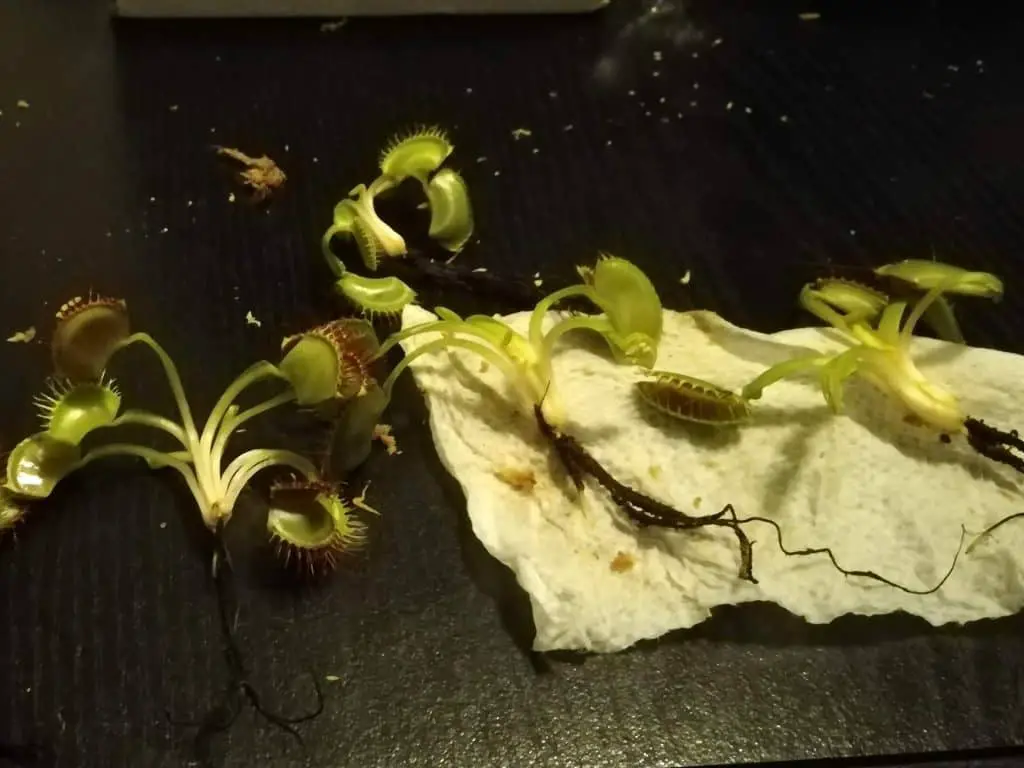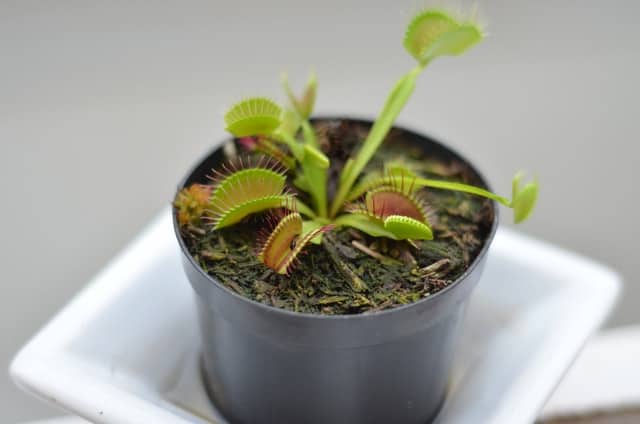Venus flytraps require several elements to stay healthy. If your plant is starting to look sick or losing leaves, you might be experiencing root rot. I have grown Venus flytraps for several years. And, along the way, I have made mistakes and learned how to overcome them. With this article, I would like to share a guide to detect Venus flytrap root rot and give you advice on how to save your plant.
Venus flytraps can be affected by root rot when grown in humid environments. The root rot weakens the plant, and if the conditions do not change, root rot can kill the plant. The signs of root rot are abnormal smell, an increase in black leaves, and color and texture changes in the plant’s bulb.
If your plant is suffering from root rot, you can still save it. Do not get discouraged! Instead, read the guide below and follow some easy procedures to save your Venus flytrap.
Venus Flytrap Root Rot Causes
Root rot is caused by overwatering Venus flytrap or exposing them to fungus or bacteria.
Venus flytraps require substantial amounts of water to survive. The general rule is to keep the soil moist at all times. You should never let the soil dry out completely.
Even though Venus flytraps require constant watering, some people can give their plants too much love and accidentally harm them. The soil should be moist, but it shouldn’t be damped.
Over-watered soil promotes the growth of harmful bacteria and fungus. The bacteria and fungus consume your plant’s matter. When the soil is damped, fungus and bacteria start consuming the bulb of you Venus flytrap.
In the wild, Venus flytraps live in humid habitats. However, they are not aquatic plants, and they are not used to swamp-like conditions.
“Venus flytrap occupies distinct longleaf pine habitats in the two regions of the Carolinas – Coastal Plain and the Sandhills. In the Coastal Plain where it is more common, Venus flytrap occurs in wet loamy pine savannas and sand pine savannas. These sites are generally flat with wet or moist soils for much of the year. ”
Venus Flytrap
Under Endangered Species Act review
U.S. Fish & Wildlife Service
Clear Signs of Root Rot
If you believe your plant is experiencing root rot, but are uncertain, you can use the following list to make an accurate diagnosis:
- Rotting smell: Get close to your plant and try to detect any strange smell. Usually, a trap decomposing a bug might exhibit a bit of a scent, but the plant shouldn’t have a rotting odor.
- An increase in black leaves: Venus flytraps naturally exchange leaves, older leaves blacken, and new ones spur from the bulb. Even though black leaves are a normal part of the plant’s cycle, an increase in black leaves is a warning sign.
- Changes in your plant’s bulb: Dramatic changes in the bulb of your plant are clear signs of root rot. The roots and bulb of your Venus flytrap are underground. Therefore, you must remove the plant from the soil to confirm a root rot. A healthy bulb is white and has some pink coloring in the edges. Rotting bulbs have dark spots or areas. Also, a rotting bulb has a squishy and slimy feel.

Remember! Your Venus flytrap can be down for several reasons:
- Wrong water source
- Lack of proper sunlight
- Inappropriate feeding
- Dormancy
Regardless of having a root rot or not, you should always follow all the Venus flytrap care considerations. You can get the whole overview here :
:
How to Save your Venus Flytrap from Rotting
When your Venus flytrap has a root rot, you must act quickly. Follow the steps below to save your plant from rotting.
1- Remove your Venus Flytrap from the Soil
Carefully remove your Venus flytrap from the soil. Remove all the big chunks of soil manually and then wash the bulb and the roots with distilled or reverse osmosis water (rainwater is also an option).
2- Remove the Affected Area
Now, you will have to bring out your inner surgeon skills! Use a small pair of scissors to trim the affected area. Remove the rotting part of the bulb and roots attached to it.
At this point, you should also trim any dead leaves. Your plant needs to focus on recovering and producing healthy leaves and roots.
If your plant has been dramatically affected by root rot, you can consider trimming a few unhealthy looking traps (following these instructions) so that your plant can focus on maintaining the healthy ones alive and producing new ones.
3- Repot your Plant in Clean Soil
Discard the old soil. Clean the plant container thoroughly and place new soil inside the pot. Now, carefully plant your Venus flytrap in the new soil. Make sure the roots fit comfortably, and the ground fully covers the bulb.
Choose an appropriate soil mix to prevent rotting in the future. Venus flytrap soil usually consists of a combination of moss, either Long-fibered sphagnum moss or sphagnum peat moss and sand or perlite.
You can also consider using a fungicide spray to prevent any remaining fungal agents from spurring.
4- Water your Plant and Monitor its Condition
Venus flytraps need water. Therefore, you still need to water your plant, but be extra careful. Use your fingers and press the soil after watering. You should feel the moisture in the ground. Yet, your fingers shouldn’t feel water or a swamp-like texture.
Now, it is time to monitor your plant and make sure it recovers. Be especially careful in providing enough sunlight during this period. Your plant needs all the strength it can get to improve.
How to Prevent Root Rot
Soggy ground conditions and exposure to fungus and bacteria can cause root rot. Follow this advice to prevent root rot from happening in the first place.
- Use the right soil with enough drainage
- Repot your Venus flytrap every year to prevent soil compression
- Test the soil humidity after watering
Now, let’s explore each item in detail:
Use the Right Soil with Enough Drainage
Venus flytraps require nutrient free soil with good drainage. Most growers utilize a combination of these components to create a Venus flytrap friendly soil:
- Long-fibered sphagnum moss
- Sphagnum peat moss
- Sand
- Perlite
You can find all of these components in any gardening store. The moss holds water to provide the moist environment we need. And the perlite and sand help with drainage and loosen up the soil.
Some growers plant Venus flytrap directly into Long-fibered or peat moss. I prefer to combine moss with sand or perlite. Sand and perlite both help air the soil. These components are vital to preventing excessive moisture and reduce the chances of root rot.
Repot your Venus Flytrap Every Year
When you keep plants in the same soil for long periods, the soil tends to compress. Soil compression slows the plant’s growth as roots have to fight their way through the ground. Also, when the ground is compressed it tends to hold more water.
Repot your plant every year to prevent soil compression. Also, the new soil has less chances of holding fungal or bacterial elements.
Test the Soil Humidity After Watering
Prevent root rots by always watering your plant appropriately. Use your fingers to sense the moisture in the soil after watering. Keep the ground moist, but not wet or damped. Then, wait until the moisture starts drying out before watering again.
Also, you should adjust your watering schedule to the season. I live in Phoenix, Arizona and the summer heat can be brutal. I water my Venus flytraps constantly during the summer. But during the winter, I space the watering a few extra days.
Some people use the water reserve strategy, where they place their Venus flytrap pot on top of a container or plate with water. This practice is common and it is very efficient. But, you must follow these considerations to prevent root rot:
- Do not fill the whole container with water. Venus flytraps do not grow properly on standing water.
- Let the water level lower until almost empty.
- Pour an inch of water in the container when you refill.

Sources
https://www.fws.gov/southeast/pdf/fact-sheet/venus-flytrap.pdf
D’Amato, P. (2013). The Savage Garden. Berkeley, Unites States: Ten Speed Press.
